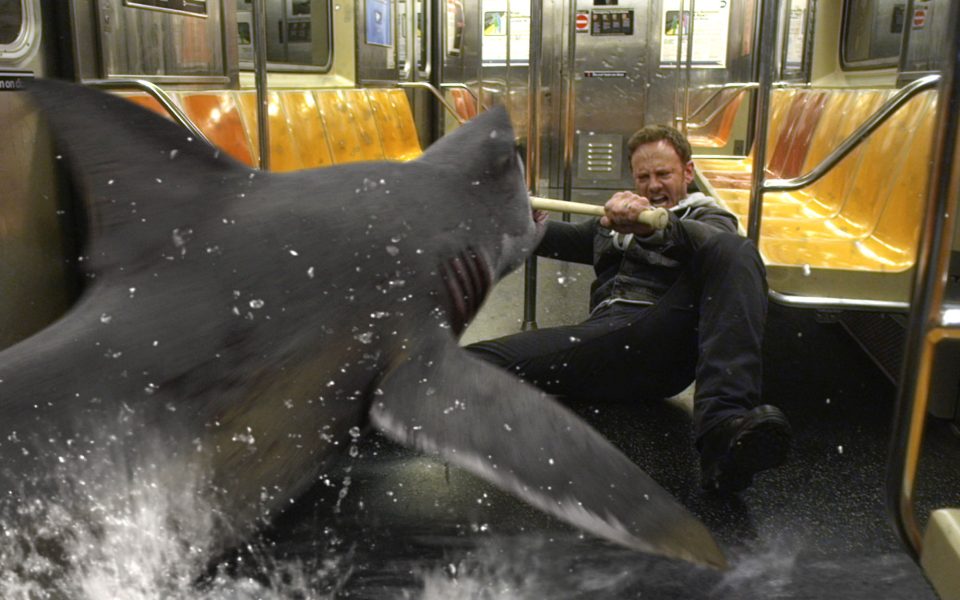by Kelly Fahey
Last Wednesday marked the release of the SyFy channel’s original movie Sharknado 2: The Second One. So naturally, I jumped at the opportunity to head to Geeksboro to take in all that this ridiculous film had to offer.
The first Sharknado exploded with popularity in a way that no SyFy original movie has. I like to imagine the half-stoned creative team sitting in their office bouncing ideas off of each other when one of them looks up from his “Doctor Who” notepad and proclaims: “What if we made a tornado filled with… sharks!?” The execution was even worse than the idea, but anyone who saw former “Beverly Hills 90210” star Ian Ziering chainsaw his way out of the belly of a great white shark in the first incarnation knew that not only did this film have to be a hit, but there would eventually be a sequel.
Ziering reclaims his role as Fin Shepard, the man who saved Los Angeles from the deadly sharknado in the original. In The Second One, he’s tasked with protecting New York City from dual sharknados with the help of his ex-wife April, portrayed by Tara Reid; his brother-in-law and sworn enemy, played by Sugar Ray’s Mark McGrath; and his former love interest Skye, played by Vivica A. Fox. Continuing the obscure-celebrity parade are cameos by the likes of Andy Dick, Billy Ray Cyrus and Biz Markie. The highlight of the film for me was when Matt Lauer repeatedly stabbed a painfully obvious CGI shark with the tip of an umbrella.
Sharknado 2: The Second One may be the single most self-aware film of all time. Whether this is a good or bad thing, I really can’t say. I’m a huge fan of the B-movie, even when B-movies were classics, like the old film noirs of Hollywood’s Golden Age, packed with stars the likes of Humphrey Bogart and Robert Mitchum, but a B-movie that is totally aware of the fact that it is a B-movie and has no problem accepting and even thriving behind that stigma? Oh the irony.
Back in the day, theaters showed double features. The bottom half of these double features were often what came to be known as a B-movie. They were less publicized and somewhat raunchy for their time, featuring taboo themes like murder or infidelity. They were cheap to make and, due to the low overhead, typically brought back huge sums of money.
The epitome of B-movies are the horror films produced by Hammer Film Productions from the UK. Throughout the ’50s and ’60s, this film company churned out fantastic horror films quicker than they could be watched. They re-used sets and actors, and made sequel after sequel. The American film market ate these projects up, and that’s where the money was at the time.
If Hammer Films was the prototype for classic B-horror films, then Troma Films is what made it acceptable for these films to be terrible. Don’t get me wrong, I love Troma Films, but they are in no way “good” in the classical sense. Lloyd Kaufman, the founder of Troma Films, visited Geeksboro back in June. Kaufman is the master of the excessive violence, nudity and smut prevalent in his films, most notable of which are The Toxic Avenger and Surf Nazis Must Die.
And that is the abridged history of how a film like Sharknado 2: The Second One was allowed to be made, and benefit from such insane hype. Sharknado 2 is a product of the unabashed irony and internet sensationalism that sticks to my generation’s bones. As I write this article, Sharknado 2 tops the list of trending Twitter topics. There’s even a “shark yourself” app, which allows users to insert photos of themselves inside the jaws of a shark.
Sharknado 2: The Second One was terrible, but I liked it nonetheless. You can’t make fun of this film, simply because its purpose is to make fun of itself. It’s essentially an inside joke whose punchline is that we, as viewers, let this happen. Hundreds of years of cultural and technological advancement led to Sharknado 2: The Second One and I say, why not make it a trilogy?
Join the First Amendment Society, a membership that goes directly to funding TCB‘s newsroom.
We believe that reporting can save the world.
The TCB First Amendment Society recognizes the vital role of a free, unfettered press with a bundling of local experiences designed to build community, and unique engagements with our newsroom that will help you understand, and shape, local journalism’s critical role in uplifting the people in our cities.
All revenue goes directly into the newsroom as reporters’ salaries and freelance commissions.


Who is this Kelly Fahey guy and when can we start putting him in the conversation as the next great film critic of our time? I’m paraphrasing Fahey here when I say Doritos taco locos are the best Mexican food I have ever eaten. Fahey’s work is becoming an unabashed essential tool in any young film watcher’s tool box. Much like the Sharknado franchise, Fahey’s work is worth a second one, maybe a third review.